Digging Chas's Digby Graham Christian Digging
Week, 27th August - 3rd September 2006 A digging diary
of the Clockwork Caving Club. Pictures
This
event was proposed as a way of celebrating 60 years of the club and in honour
of the fact that it was mainly formed as a result of digging into Ogof Ffynnon
Ddu. The plan for the week was to run a couple of digging teams to give a choice
of location and interest for members. For some strange reason I was allocated
a role in the "Clockwork" team, that would make major use of mechanical
assistance in their digging project. This article focuses only on that half of
the events of the week.
Prior to the digging week, a number of members had
wandered over to look at the site of one of Chas Jay's old digs. Just beyond the
Byfre sink, in an easterly direction, there is a small stream that runs north
out of the Nature Reserve onto the Cnewr Estate and sinks in a large shake hole.
On the eastern side of the shake hole is an exposure of solid limestone, while
the rest of the depression is in boulder clay with a peat floor. The stream has
cut down through the peat, leaving a number of limestone blocks exposed, and it
sinks in wet weather by the east wall. In drier weather, it either does not run
at all, or sinks in stages across the depression. It appears that the shake hole
depression formed in the past, then underwent a long period of sustaining a pond
or marshy bottom that allowed a considerable deposit of peat to form. At a later
stage, water found a more open path through the bottom of the shakehole by the
east side, and started washing the in-filling peat away into whatever cavities
may lie below.
Chas was questioned on the history of his digging and what
he had found. He claimed that he had found evidence of cave passage, before the
dig slumped in. It appears that instability was a feature of this dig, so we resolved
to make sure that the shuttering was adequate from the start. Sunday
27th August
A collection of digging tools was taken from the stores and
a good number of people went to assess the site for how we were going to tackle
it. The back wall seemed sound enough, so we knew that we had something to which
scaffold bars could be bolted. The dip of the rock seemed to be in a south-easterly
direction, so we were hopeful that cave passage might possibly head that way too. 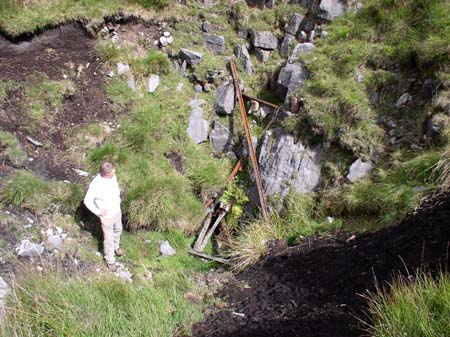
Jopo
examining the tat that we had to clear before starting digging Chas's old dig.
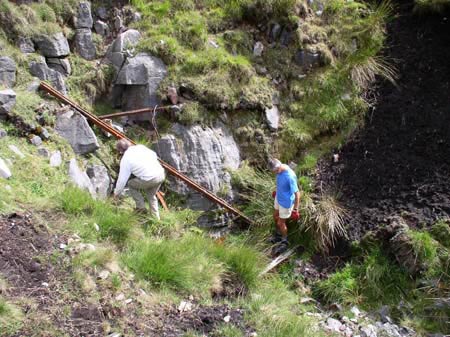
Jopo
and Brian at Chas's Old dig before starting digging.
Also on
the area, a narrow, north-south trending rift was examined. This is also on Cnewr
land and is just to the north of Steel Drum Dig. On the old timbers that "protected"
the hole was an old rusty razor blade. A working name of Razorblade Pot was coined.
Again an assessment was made of what tackle would be needed to get down it and
have a thorough examination of its potential. 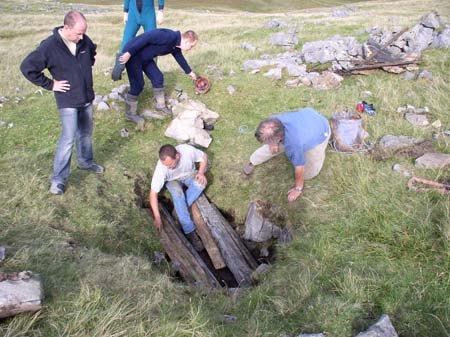
Hywel
Jopling re-covering Razorblade Pot after its first examination.
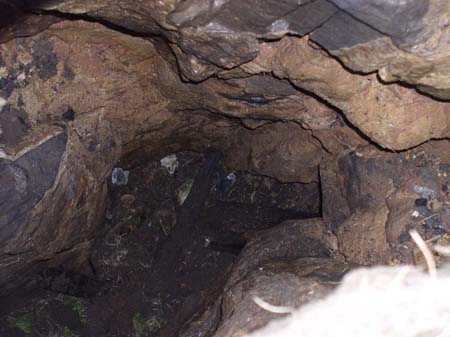
Looking
straight down Razorblade Pot.
Monday 28th August
A load
of scaffolding poles, attendant clamps, spanners, hammers, drills, bolts, picks,
spades, buckets, ropes and all the other tat that a good dig warrants was transported
up to the site. Dry ground meant that we could park off the track without causing
any damage.
A round of scaffolding was set and the digging was started. Old
wire was snipped out, wiggly tin wiggled out and old wood wrenched from the clutches
of the slumped peat. The digging buckets were the ones designed for Babysitters'
Dig, so could only be partially filled for hauling by hand.
Meanwhile, over
at Razorblade Pot, a descent had been made, it was pronounced interesting, and
concrete lintels were transported to the site to cover it over in a more secure
manner than previously.
A second load of scaffolding poles was transported
up to Chas's Old Dig.
Tuesday 29th August
Roof-loads of shuttering
timber were the order of the day, as once again the workhorses of Graham's Land
Rover and Simon's Range Rover were pressed into use. A zip-wire was installed
over the dig and tensioned up to a substantial length of steel channel that was
hammered a considerable distance into the ground. 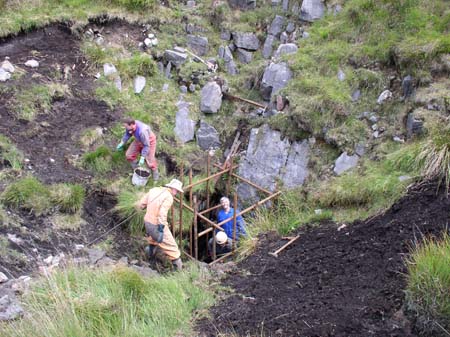
The
scaffolding for the shuttering is in place.
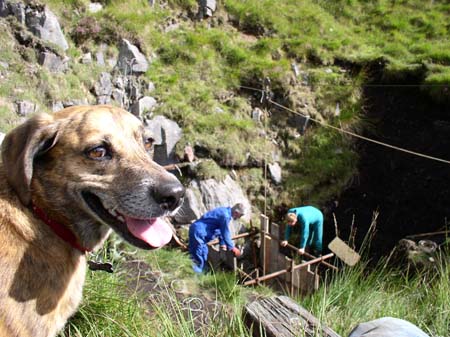
Bonnie
keeps an eye on the workers.
We could now haul buckets up from the
dig, then move them sideways on a pulley to an area where we could unload into
a wheelbarrow (fetched from Babysitters' Dig). Big rocks that came out of the
deepening hole were dumped in the channel of the stream to make steps and the
finer stones, gravel, sand and peat barrowed to the side of the shakehole, well
above the stream course.
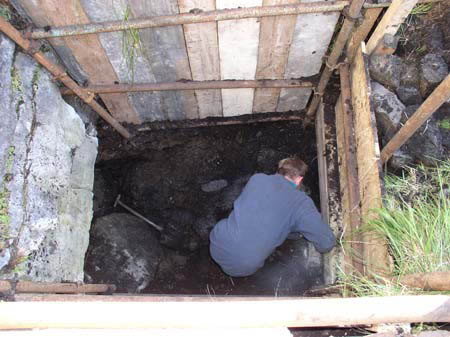
With
timbering in place, Ian starts to treat a rock for shock.
That
evening, over a beer or several, there was much discussion on improving the hauling
system. Wednesday 30th August
More timber was taken up and a bit
of time spent on fiddling with the rigging. The digging started and the rigging
further refined as the day went on. We used a 2:1 advantaged pulley system and
"blondin" arrangement that allowed the bucket to be hauled straight
up out of the dig, the hauling rope to be locked off, then the blondin rig and
bucket traversed sideways to the unloading point by a separate continuous looped
rope. 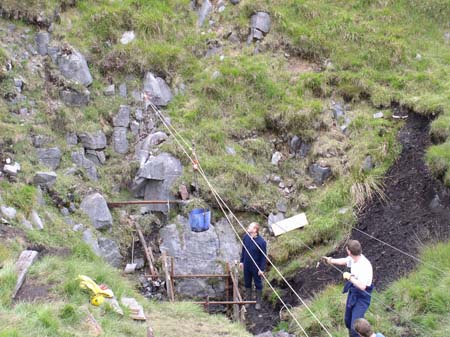
A
lightly filled bucket is hauled up at 2:1 [hauling ratio]
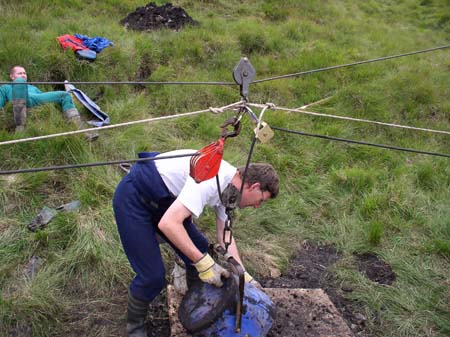
The
improvised "Blondin" pulley system.
At the end of the
day, we were over 2 metres down, with the wooden shuttering being pushed down
behind the scaffold poles as we went. We packed up just in time for it to start
raining.
Thursday 31st August
It continued to rain, so we
spent the morning fettling scaffold clamps in the workshop. As the weather had
improved after lunch we were able to put in more scaffolding and planks all round.
Only a few bucket loads were hauled out.
Friday 1st September
After
the rain, water flowing across the floor of the dig was now a feature for a while.
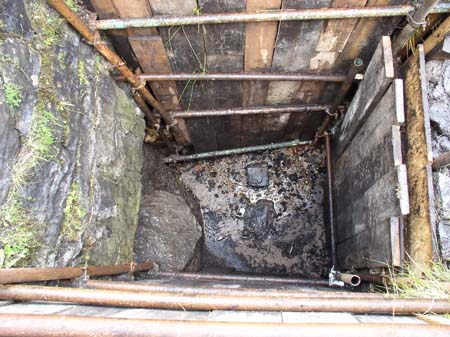
Clean
pebbles and sand at the bottom of the dig after rain.

Getting
deeper, and water at the bottom.
Many buckets of sludge and rock
came out of the hole today, necessitating more scaffolding down and round the
dig. A good sign was the appearance of a low bedding plane under the back wall
at floor level. This seemed to go back over a metre and have a floor of clean-washed
pebbles. We had found a void!
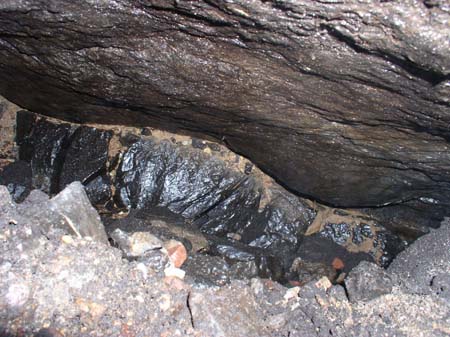
The
view into the bedding plane under the back wall.
Saturday 2nd
September
It was wet overnight and continued to pee down all day, so no
digging. With this weather as inspiration, the South Wales Clockwork Cavers evolved
into the South Wales Computer Club and spent the day working with the rainfall
data that had been gathered over the year. Scripts and programs were written to
make manipulation of the raw data far easier. Simon and Annie did the honourable
thing and took the dog for a walk up to the dig to see what was happening. They
reported back that the stream which was now flowing, did not make it to the dig,
but was sinking in the middle of the floor of the shakehole. However, it then
reappeared in the bottom of the dig, flowed across the floor and disappeared into
the bedding plane at the back and showed no sign of backing up at all.
Sunday
3rd September
The bottom of the dig was now clear of peat - all washed
through, with a bit of foam clinging to the roof of the bedding plane. Yet more
scaffolding was put in and adjusted. Tony Donovan hove into view and sent a quantity
of optical brightener on its way to a resurgence. The Nedd and Tawe valleys were
both to be monitored over the next week. After a good week's progress - down at
least 3 metres - we packed all the gear up and boarded over the hole.
The optical
brightener turned up on the following Tuesday at the Ffynnon Ddu resurgence and,
surprisingly, the pool opposite Craig-y-Nos Castle. We are unsure of quite what
the last bit means, so further tracing is planned.
Saturday 23rd
September
A small team was mustered, access permission sought and another
fine day was spent on the hill. This time the petrol-engined winch was taken up
and rigged into the blondin system. It worked so well that we were able to prove
that just one person could haul the bucket up, traverse it to the unloading point,
tip the contents into the wheelbarrow and dump the spoil. By using 2 buckets fully
laden each time, we were able to drop the floor by about another metre in this
one day.
What was most interesting was that we were able to pull rocks out
of the floor and find gaps beyond, from which draughts of cool air were blowing
out.
Sunday 24th September
No digging was done today, but
even more scaffolding was put into the bottom of the dig. It was quite awkward
putting it in, but we want to reduce the chances of a run-in to a minimum. The
blondin system is still in need of refinement, but work is already in progress
to address our needs. Acknowledgements
Thanks to Jopo and Tony
Baker for "championing" the week and making sure it happened. Thanks
to Cnewr Estate for the permission to take vehicles with the heavy stuff onto
their land and their tolerance of the club poking about in interesting holes.
Thanks
to Tony Donovan and Roy Morgan for the many miles driven over the next week to
collect detector bags for the dye tracing.
Diggers to the east of the Tawe
in approximately chronological order:
Brian Jopling, Graham Christian, Sam
Moore, Brian Clipstone, Hywel Jopling, Ian Cardy, Ash Burrows, Brendan Marris,
Simon Amatt, Annie Amatt, Mick Day, Harvey Lomas, Ian Alderman, Andy Dobson, Dave
Dobson, Clark Friend, Paul Craddy, Gareth Davies, Ben Stevens, Chris Grimmett.
Observers
and fan club:
Dave Edwards, Dan Sullivan, Pete Francis up
to the top? Graham Christian, 26th September 2006
| 